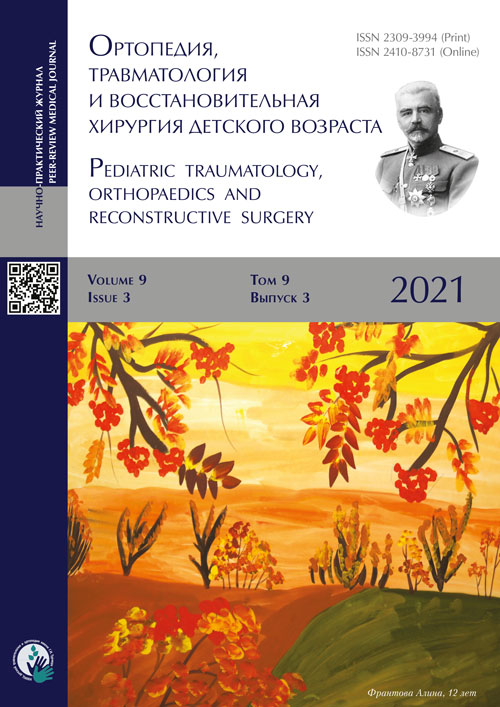First metatarsal elevation after subtalar arthroeresis in children with flatfeet
- Authors: Sapogovskiy A.V.1, Boyko A.E.2, Rubtsov A.V.3, Rubtsova N.O.4
-
Affiliations:
- H. Turner National Medical Research Center for Сhildren’s Orthopedics and Trauma Surgery
- Gatchina Clinical Interdistrict Hospital
- Moscow Pedagogical State University
- Russian State University of Physical Education, Sport, Youth And Tourism
- Issue: Vol 9, No 3 (2021)
- Pages: 297-306
- Section: Original Study Article
- Submitted: 08.07.2021
- Accepted: 31.08.2021
- Published: 04.10.2021
- URL: https://journals.eco-vector.com/turner/article/view/75828
- DOI: https://doi.org/10.17816/PTORS75828
- ID: 75828
Cite item
Abstract
BACKGROUND: Arthroereisis of the subtalar joint is a common surgical option for children with flat feet. Along with all the advantages of arthroereisis of the subtalar joint, the indications for surgery, the optimal age for surgical treatment, as well as secondary deformities of the forefoot that occur after treatment are debatable.
AIM: The aim of this study was to analyze the frequency and degree of I metatarsal elevation after arthroereisis of the subtalar joint in children.
MATERIALS AND METHODS: The study group included 106 patients / 202 feet who were treated at H. Turner National Medical Research Center for the period from 2015 to 2019. The average age was 11 years (8; 13). Arthroereisis of the subtalar joint was performed in two variants: arthroereisis with a locking screw in the calcaneus — 44 patients / 83 feet and arthroereisis with a locking screw in the talus — 62 patients / 119 feet. An analysis was made of the incidence of I metatarsal elevation after arthroereisis of the subtalar joint. The relationship between the degree of elevation of the first metatarsal bone and the main clinical and radiological characteristics of the feet at different times after surgical treatment was analyzed.
RESULTS: The frequency of elevation of the I metatarsal bone with the use of a calcaneal locking screw was 20.7%, and with the use of a talar locking screw, the frequency is 51.6%. Clinical manifestations of elevation of the I metatarsal bone took place when the amount of elevation was more than 65% of the size of the head of the I metatarsal bone. At a period of 2–3 years after the operation, elevation of the I metatarsal bone were noted in 15.9%. A statistically significant correlation (Spearman coefficient) was noted between the degree of elevation of the I metatarsal bone and the following parameters: anteroposterior Meary angle (–0.360), lateral Kite angle (–0.367), lateral Meary angle (–0.378), foot arch angle (0.344), tibio-talar angle (–0.351), Friedland’s index (0.402).
CONCLUSIONS: Incidence of the first metatarsal bone elevation reaches 51% of the in patients in the immediate follow-up period after performing arthroereisis of the subtalar joint. Elevation of the first metatarsal bone developed dorsal bunion with an elevation value of more than 65%. The degree of elevation of the first metatarsal bone has a positive correlation with the degree of planovalgus deformity correction. Elevation of the first metatarsal bone tends to decrease up to 15% in the long-term follow-up after surgical treatment.
Full Text
About the authors
Andrey V. Sapogovskiy
H. Turner National Medical Research Center for Сhildren’s Orthopedics and Trauma Surgery
Author for correspondence.
Email: sapogovskiy@gmail.com
ORCID iD: 0000-0002-5762-4477
SPIN-code: 2068-2102
MD, PhD
Russian Federation, 64–68 Parkovaya str., Pushkin, Saint Petersburg, 196603Aleksey E. Boyko
Gatchina Clinical Interdistrict Hospital
Email: lex.trol@mail.ru
ORCID iD: 0000-0002-0615-9907
MD, orthopedic and trauma surgeon
Russian Federation, Gatchina, Leningrad regionAleksey V. Rubtsov
Moscow Pedagogical State University
Email: alexey.rubtzov@gmail.com
ORCID iD: 0000-0003-4339-3150
SPIN-code: 2077-4542
PhD in Pedagogical Sciences, Associate Professor
Russian Federation, MoscowNataliya O. Rubtsova
Russian State University of Physical Education, Sport, Youth And Tourism
Email: nataly.rubtzova@gmail.com
ORCID iD: 0000-0002-7176-7677
SPIN-code: 8967-3768
PhD in Pedagogical Sciences, Professor
Russian Federation, MoscowReferences
- Kenis VM. Tarzal’nye koalicii u detej: opyt diagnostiki i lechenija. Travmatologija i ortopedija Rossii. 2011;(2):132−136. (In Russ.).
- Kenis VM. Oshibki i oslozhnenija konservativnogo lechenija deformacij stop u detej s DCP / sb. nauchn. statej, posvjashhennyj 125-letiju Nauchno-issledovatel’skogo detskogo ortopedicheskogo instituta imeni GI. Turnera. Saint Petersburg: Jeko-Vektor; 2017. P. 145−152. (In Russ.).
- Dimitrieva AJu. Vzaimosvjaz’ mezhdu zhalobami na bol’ i urovnem trevozhnosti u detej s mobil’nym ploskostopiem. In: Sb. mat. XIII Vserossijskoj nauchno-prakticheskoj konferencii s mezhdunarodnym uchastiem “Voroncovskie chtenija”. Saint Petersburg: Sankt-Peterburgskoe regional’noe otdelenie obshhestvennoj organizacii “Sojuz pediatrov Rossii”; 2020. P. 14−15.
- Costa FP, Costa G, Carvalhoet MS, al. Long-term outcomes of the calcaneo-stop procedure in the treatment of fexible fatfoot in children: a retrospective study. Acta Med Port. 2017;30(7−8):541−545. doi: 10.20344/amp.8137
- Fernández de Retana P, Álvarez F, Viladot R. Subtalar arthroereisis in pediatric flatfoot reconstruction. Foot Ankle Clin. 2010;15(2):323−335. doi: 10.1016/j.fcl.2010.01.001
- Yoshioka N, Ikoma K, Kido M, et al. Weight-bearing three-dimensional computed tomography analysis of the forefoot in patients with flatfoot deformity. J Orthop Sci. 2016;21(2):154−158. doi: 10.1016/j.jos.2015.12.001
- Evans EL, Catanzariti AR. Forefoot supinatus. Clin Podiatr Med Surg. 2014;31(3):405−413. doi: 10.1016/j.cpm.2014.03.009
- Christensen JC, Campbell N, Dinucci K. Closed kinetic chain tarsal mechanics of subtalar joint arthroereisis. J Am Pod Med Assoc. 1996;86:467−473. doi: 10.7547/87507315-86-10-467
- Gutièrrez PR, Herrera LM. Giannini prosthesis for flatfoot. Foot Ankle Int. 2005;26(11):918−926. doi: 10.1177/107110070502601104
Supplementary files
















